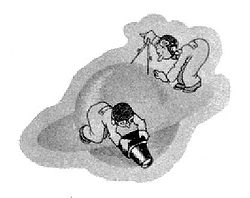36th Intelligence Squadron
 | |
|---|---|
 Emblem of the 36th Photographic Reconnaissance Squadron | |
| Active | 1942–1946; 1990-Present |
| Country |
|
| Branch |
|
| Decorations |
Philippine Presidential Unit Citation Air Force Meritorious Unit Award Air Force Outstanding Unit Award Air Force Organizational Excellence Award |
| Insignia | |
| 36th Intelligence Squadron Emblem. |
 |
The 36th Intelligence Squadron is an active non-flying squadron, of the United States Air Force. It is assigned to the Air Force Targeting Center at Langley AFB, Virginia, where it has been stationed since 1990. The squadron has earned the Air Force Meritorious Unit Award, the Air Force Outstanding Unit Award, and the Air Force Organizational Excellence Award while stationed at Langley.
During World War II the squadron served in the Pacific as the 36th Photographic Reconnaissance Squadron The squadron earned the Philippine Presidential Unit Citation for its combat operations during the Liberation of the Philippines in 1944–1945.
History[]
The squadron was first activated in the summer of 1942 as the 28th Observation Squadron, one of the squadrons of the 73d Observation Group at Godman Field, Kentucky, where it was equipped with the Bell P-39 Airacobra.[1] The squadron engaged in training activities including the Tennessee maneuvers of 1943.[2]
During World War II, the squadron operated primarily in the Southwest Pacific Theater, providing aerial reconnaissance and intelligence information over a wide area of the theater in numerous campaigns. In 1945, it performed reconnaissance missions over Formosa as well as the Philippines.[3] The squadron earned the Philippine Presidential Unit Citation for its combat operations during the Liberation of the Philippines in 1944–1945. Following the Japanese surrender the squadron moved to Japan, briefly serving as part of the occupation forces, but returned to the Philippines at the end of 1945 and was inactivated in 1946.[1]
The squadron was reactivated as an intelligence unit supporting Tactical Air Command (TAC) in 1990. When Air Combat Command replaced TAC in 1992, the 36th was transferred along with its parent group.[4] In February 2008, it was reassigned to the Air Combat Command Targeting and Intelligence Group. Although much of its history remains classified, it has won numerous awards for its performance.
Lineage[]
- Constituted as the 28th Observation Squadron on 1 July 1942
- Activated on 17 July 1942
- Redesignated: 28th Reconnaissance Squadron (Fighter) on 2 April 1943
- Redesignated: 28th Tactical Reconnaissance Squadron on 11 August 1943
- Redesignated: 36th Photographic Mapping Squadron on 9 October 1943
- Redesignated: 36th Photographic Reconnaissance Squadron on 29 March 1944
- Inactivated on 20 February 1946[5]
- Redesignated 36th Tactical Intelligence Squadron and activated on 1 September 1990
- Redesignated 36th Air Intelligence Squadron on 1 November 1991
- Redesignated 36th Intelligence Squadron on 1 October 1993[4]
Assignments[]
|
|
Stations[]
|
|
Aircraft[]
|
Attack and Bomber Aircraft
|
Fighter Aircraft
|
Observation and Liaison Aircraft
|
Awards and Campaigns[]
| Award streamer | Award | Dates | Notes |
|---|---|---|---|
| Air Force Meritorious Unit Award | 1 June 2004 - 31 May 2006 | 36th Intelligence Squadron[4] | |
| Air Force Meritorious Unit Award | 1 June 2006 - 31 May 2007 | 36th Intelligence Squadron[4] | |
| Air Force Outstanding Unit Award w/Combat "V" Device | 1 June 2002 - 31 May 2003 | 36th Intelligence Squadron[4] | |
| Air Force Outstanding Unit Award | 1 September 1990 - 31 December 1991 | 36th Tactical Intelligence Squadron (later 36th Air Intelligence Squadron)[4] | |
| Air Force Outstanding Unit Award | 1 January 1992 - 30 September 1993 | 36th Air Intelligence Squadron[4] | |
| File:AFOEA Streamer.JPG | Air Force Organizational Excellence Award | 1 October 1993 - 30 September 1995 | 36th Intelligence Squadron[4] |
| Philippine Republic Presidential Unit Citation | 17 October 1944 - 4 July 1945 | 36th Photographic Reconnaissance Squadron[4] |
Manual campaign table
| Campaign Streamer | Campaign | Dates | Notes |
|---|---|---|---|
| American Theater | 28th Observation Squadron (later 36th Photographic Mapping Squadron)[1] | ||
| New Guinea | 36th Photographic Reconnaissance Squadron[1] | ||
| Western Pacific | 36th Photographic Reconnaissance Squadron[1] | ||
| Luzon | 36th Photographic Reconnaissance Squadron[1] | ||
| Southern Philippines | 36th Photographic Reconnaissance Squadron[1] | ||
| China Offensive | 36th Photographic Reconnaissance Squadron[1] |
References[]
Notes[]
- ↑ 1.0 1.1 1.2 1.3 1.4 1.5 1.6 1.7 Maurer, Maurer, ed (1982) [1969]. Combat Squadrons of the Air Force, World War II (reprint ed.). Washington, DC: Office of Air Force History. p. 173. ISBN 0-405-12194-6. LCCN 70605402. OCLC 72556. http://www.airforcehistory.hq.af.mil/Publications/fulltext/combat_sq_of_the_af_wwii.pdf.
- ↑ Maurer, Maurer, ed (1983) [1961]. Air Force Combat Units of World War II (reprint ed.). Washington, DC: Office of Air Force History. p. 50. ISBN 0-912799-02-1. LCCN 61060979. http://www.airforcehistory.hq.af.mil/Publications/fulltext/af_combat_units_wwii.pdf.
- ↑ Abstract, History 36th Photo Recce Sq Apr 1945 (retrieved July 15, 2013)
- ↑ 4.00 4.01 4.02 4.03 4.04 4.05 4.06 4.07 4.08 4.09 4.10 Butler, William M., AFHRA Factsheet , 36th Intelligence Squadron 11/9/2010 (retrieved July 15, 2013)
- ↑ 5.0 5.1 5.2 5.3 Lineage, assignments, stations, and aircraft through 1946 in Maurer, Combat Squadrons, p. 173
- ↑ Air Force Organization Change Status Report, June 2008, Research Division, Air Force Historical Research Agency
Bibliography[]
This article incorporates public domain material from the Air Force Historical Research Agency website http://www.afhra.af.mil/.
- Maurer, Maurer, ed (1983) [1961]. Air Force Combat Units of World War II (reprint ed.). Washington, DC: Office of Air Force History. ISBN 0-912799-02-1. LCCN 61060979. http://www.airforcehistory.hq.af.mil/Publications/fulltext/af_combat_units_wwii.pdf.
- Maurer, Maurer, ed (1982) [1969]. Combat Squadrons of the Air Force, World War II (reprint ed.). Washington, DC: Office of Air Force History. ISBN 0-405-12194-6. LCCN 70605402. OCLC 72556. http://www.airforcehistory.hq.af.mil/Publications/fulltext/combat_sq_of_the_af_wwii.pdf.
The original article can be found at 36th Intelligence Squadron and the edit history here.